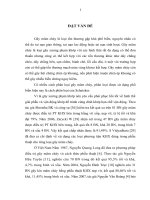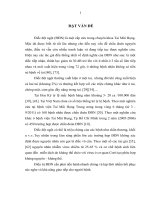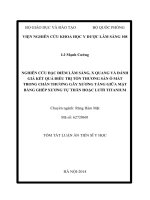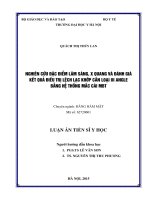Nghiên cứu vai trò của xạ hình xương và đánh giá kết quả điều trị sarcom xương tt tiếng anh
Bạn đang xem bản rút gọn của tài liệu. Xem và tải ngay bản đầy đủ của tài liệu tại đây (126.58 KB, 27 trang )
MINISTRY OF EDUCATION
AND TRAINING
MINISTRY OF
NATIONAL DEFENCE
VIETNAM MILITARY MEDICAL UNIVERSITY
TRINH VAN THONG
STUDY THE ROLE OF BONE SCINTIGRAPHY
AND EVALUATE THE RESULTS
OF TREATMENT OF OSTEOSARCOMA
Specialty: Surgery
Code: 9720104
PH.D. THESIS SUMMARY
HANOI - 2019
THE RESEARCH WAS FINISHED AT
VIETNAM MILITARY MEDICAL UNIVERSITY
Supervisors:
1. Assoc.Prof. Ph.D. Tran Dinh Chien
2. Assoc.Prof. Ph.D. Nguyen Dai Binh
Judge 1: Assoc.Prof. Ph.D. Tran Trung Dung
Judge 2: Assoc.Prof. Ph.D. Le Ngoc Ha
Judge 3: Assoc.Prof. Ph.D. Nguyen Manh Khanh
The thesis will be defended before the Thesis Assessment Council at
Institute level
At: Vietnam military medical university
Date
month
year
The thesis can be found at:
- National library
- Vietnam military medical university library
3
INTRODUCTION
1. Regarding the current situation, necessity, scientific and practical
significance of the dissertation topic
Osteosarcoma is the most common primary bone cancer and
accounts for about 35% of all primary bone cancers. In the years
before 1980, the only treatment was amputation and even with early
surgery, the overall survival rate after 5 years was not more than 20%
and the main cause of death is due to lung metastasis.
From the 1980s onwards, the combination of chemotherapy and
then surgery has significantly improved the survival rate for patients.
When chemotherapy is combined, the problem is how to assess the
level of histomorphological response to the drug. Evaluation
measures through tissue necrosis have many limitations due to
surgical intervention and depending on method of taking samples,
reading test results…
Bone
scintigraphy
allows
assessment
of
preoperative
chemotherapy respond through TBR index changes in the tumor,
allows detection of recurrence of local lesions and more complete
distant metastasis than other diagnostic imaging methods such as
conventional X-rays, CT scans and MRI. Whereby, chemotherapy is
indicated, especially supplementation of treatment when relapsing
and metastasis is performed timely and effectively.
The dissertation topic: “Study the role of bone scintigraphy and
evaluate the results of treatment of osteosarcoma” with following
research objectives:
(1) Studying the role of bone scintigraphy in stage diagnosis and
the process of monitoring osteosarcoma treatment.
4
(2) Evaluating the effects of osteosarcoma treatment at K
hospital in Ha Noi.
2.New contributions
The dissertation is the result of bone scintigraphy research at 4
times, assessing the role of bone scintigraphy in the stage diagnosis
through the early detection of micrometastases. The appropriateness
between changing AR index before and after chemotherapy in 57
patients with biopsy results assessing the degree of tumors necrosis
has shown that bone scintigraphy can be used to evaluation the tumor
response to chemotherapy in osteosarcoma patients instead of tumor
conventional biopsy methods applied previously. The results also
showed that bone scintigraphy is very valuable in monitoring early
detection of relapse and distant metastasis.
The thesis shows results of treatment, survival rate, survival
rate, disease-free survival rate, function of preserved limbs, and
factors affecting survival rate. This is a valuable reference for
osteosarcoma treatment.
3. The dissertation structure
The dissertation consists of 129 pages, including: Introduction (2
pages), Overview (33 pages), Subjects and method (18 pages),
Results (29 pages), Discussions (47 pages), Conclusions (2 pages).
References have 118 documents including 14 Vietnamese
documents, 104 English documents. The number of documents
published from 2009 onwards has 47/118 accounting for 39,8% (4
Vietnamese and 43 English).
5
CHAPTER 1: OVERVIEW
1.1. Bone scintigraphy in diagnosis of osteosarcoma
Bone scintigraphy has a very high sensitivity, giving a general
picture of the whole bone system, helping to detect bone lesion if
any. The presence of one or more regions increasing uptake of
radionuclide called "hot zones". Such lesions may include
osteomyelitis, a recent fracture, benign bone tumors or malignant
lesions. For differential diagnosis of benign or malignant bone
lesions,
Otto
Sneppen
conducted
simultaneously
anatomical
investigation and bone scintigraphy in patients with different lesions.
With bone scintigraphy, the author measured count values at the
lesion area compared to the opposite bone area in the body (TBR).
After comparing the result, the author found high TBR index in
patients with malignant lesions and lower in benign lesions.
According to the author, the threshold of TBR index: 1.5 is
considered as the threshold that distinguishes benign and malignant
lesions on bone scintigraphy.
The presence of secondary lesion (metastasis) of bone changes
the stage of the tumor to stage III (Enniking) from any stage and
therefore, the treatment strategy also changes. In osteosarcoma,
micrometastasis is present in about 20% of patients before starting
treatment. This explains why prior to the development of
chemotherapy, although the decision of amputations was extensive
for cases of osteosarcoma, the rate of early relapse after treatment
was also high.
Bone scintigraphy, in addition to the role of primary tumor
monitoring through stages in which the patient is at risk of
developing bone metastases, is also used to detect possible tumor
6
mass after chemotherapy. The change in radiation uptake (reduction
or disappearance) after treatment shows tumor cell necrosis. The
changes TBR index before and after treatment shows the grade of
respond to treatment.
1.2. Histopathological Diagnosis
The histopathological results are the criteria in diagnosing
osteosarcoma. Biopsy play an important role to accurately diagnose
of tumor malignancy before treatment.
In osteosarcoma, the Hematocylin Eosine (HE) stain results
mainly determine whether the tumor composition can have three
forms: osteoblast cells, osteoclast cells and fibrous-forming cells.
In most cases, just relying on histopathology examination helps to
make the diagnosis be accurate. However, some cases of
histopathology have not been clearly distinguished. Immunohistochemistry is used to distinguish the primary bone cancer.
Immunohistochemistry analysis proves tissue origin and is an
absolute reliable method.
1.3. Diagnose the osteosarcoma stage
Enneking stage system with bone sarcoma
Primary tumor (T)
Metastasis
Stage
Malignancy (G)
IA
Low malignancy (G1)
Inside cavity (T1)
M0
IB
Low malignancy (G1)
Outside cavity (T2)
M0
IIA
High malignancy (G2)
Inside cavity (T1)
M0
IIB
High malignancy (G2)
Outside cavity (T2)
M0
III
Gx
Tx
M1
(M)
7
CHAPTER 2: SUBJECTS AND METHODS
2.1 Subjects
Research is performed on 70 patients with osteosarcoma who are
treated in Hanoi K Hospital from January 2008 to June 2014.
2.1.1. Patient’s selection criteria
The patient selected must meet the following criteria:
- Histopathological diagnosis are osteosarcoma.
- Get bone scintigraphy according to the process: Before and
after the patient has 3 cycles of preoperative chemotherapy, after
discharge and after leaving hospital for 3-6 months.
- The tumors were located in the upper and lower limbs.
- Surgical treatment combined chemotherapy with EOI regimen.
- Patients agreed to participate in research.
2.1.2. Exclusion criteria
- The patient had pulmonary metastases before treatment.
- Patients with accompanying kidney and heart diseases.
- Patients only treat surgery or chemicals alone.
- Treatment combined with other regimens from the beginning.
- Do not follow the full course of treatment.
2.2. Methods
Non-control
prospective
clinical
study,
cross-sectional
description with follow-up monitoring.
2.2.1. Histopathological diagnosis
Locate tumor on the limbs based on clinical symptoms,
radiograph images, CT scans.
Biopsy samples taken in areas of the tumor do not have necrosis
or bleeding. The minimum size of biopsy sample is 1cm.
8
Biopsy will be stained by HE and the results will be read by a
doctor in Department of Cellular Disease Surgery at K Hospital
under microscope with magnification 400. The diagnosis results of
histopathological osteosarcoma based on criterion:
- Cellular component of osteosarcoma: polymorphic, diverse,
multi-size cells with abnormal cell division (multiple nuclei), dark
alkaline-colored nucleus.
- Substrates with bone, cartilage, and fiber substances, in
which bone subtances always exists.
Osteosarcoma
classification
is
made
according
to
the
classification table of WHO, 2002.
Before surgery, remove the tumor or amputate, perform a biopsy
at least twice:
+ The first time was implemented immediately after the patient
was admitted to the hospital for a definitive diagnosis of
histopathology as osteosarcoma.
+ The second time: after the patient has 3 cycles of preoperative
chemotherapy to evaluate the histplogical effect of treatment
according to 4 Huvos’s grades.
Grade IV:
100% necrosis (Complete response).
Grade III:
90 - 100% necrosis (Good response).
Grade II:
50-89% necrosis (Partial response).
Grade I:
< 50% necrosis(No response).
2.2.2. Bone scintigraphy
Whole body bone scintigraphy is performed on SPECT (Single
Photon Emission Computed Tomography). 740 MBq
99m
Tc-MDP was
administered intravenously, and scintigraphic images were obtained
9
after 3 hours. Each patient with osteosarcoma was taken bone
scintigraphy at the following times:
First time: Immediately after diagnosis of osteosarcoma.
2nd time: after the end of 3 preoperative chemotherapy according
to EOI regimen with the aim of comparing with pretreatment bone
scintigraphy, to detect new bone metastatic lesions, cell necrosis and
evaluate the Grade of respond to chemotherapy, make comparision
of the suitability of two methods to assess preoperative chemotherapy
response.
- Based on the grade of tumor cell necrosis through the biopsy
tissue.
- Based on AR (Alteration Ratio) value through bone
scintigraphy.
Evaluate the change in radiation uptake expressed by the TBR of
bone scintigraphy before and after treatment. The TBR is
determined as folows: TBR = (T-BG) /BG, in which: T is the count of
radioactivity at the tumor and BG is the count at the position which is
opposite to the tumor on the body (Background). Compared
pretreatment TBR (TBR1) with post-treatment TBR (TBR2), and the
change was defined as Alteration Ratio (AR). AR(%) = (TBR1TBR2) /TBR1. The results of the alteration ratio were divided into
the following levels: good scintigraphic respond as AR ≥ 60%;
partially respond AR 20 – 60% and not respond AR < 20%.
Comparing the results of assessing the treatment respond on bone
scintigraphy with the assessment effects of treatment respond by
assessing tumor cell necrosis through biopsy tissue samples
according to Huvos.
- Result:
10
+ Normal bone scintigraphy: Distribution of radioactive
pharmaceutical density according to physiological characteristics, not
detected abnormally on bone scintigraphy. According to Otto
Sneppen, TBR > 1,5 which is diagnostic threshold of malignant
lesion. Images on bone scintigraphy may be encountered:
+ "Hot zone" is the area of increased radiation uptake.
+ "Cold zone" is the area that reduces or loses radiation uptake.
+ Mixture: Have defects in central area, also increasing
radioactivity in edging area.
+ Micrometastases are small lesions that increase radiation
uptake with TBR > 1,5.
2.2.3. Surgical treatment
- Indication to amputation surgery.
+ No response to preoperative chemotherapy: AR index <20%, tissue
necrosis after chemotherapy < 50%.
+ The main invasive nerve vascular injury of the limb.
+ Biopsy causes the tumor cell to spread into a healthy tissue.
+ Amputation surgery also indicates that there are too many
lesions spreading to the soft tissue.
+ The disease is more advanced before chemotherapy: Tumor size
increases, AR <20%, tissue necrosis after chemotherapy < 50%.
+ Relative indication: For patients who < 12 years old.
- Indication surgery to remove the tumor:
+ Response to chemothrapy: AR <20%, tissue necrosis after
chemotherapy ≥ 50%.
+ Do not invasive the main nerve and vascularity of the limb.
+ Enough soft tissue to ensure the minimum function of the limb.
11
2.2.4. Chemotherapy
Chemotherapy before surgery with EOI regimen. A total of 6
cycles (3 cycles before surgery and 3 cycles after surgery), each cycle
3 weeks apart.
After 3 cycles, a reassessment will be conducted, if:
- AR ≥20%, tissue necrosis ≥ 50%, Follow-up with EOI regimen.
- AR <20%, tissue necrosis <50%, move on to the next IE
regimen. IE: Ifosfamide regimen 3000mg /m 2 skin and Etoposide
75mg/m2 skin intravenously injected from 1-4 days, 3-4 week cycle.
Surgery are performed after assessing the level of respond to
chemotherapy. Surgery is done on the 9th week of treatment.
2.2.5. Treatment results
- Early results: evaluated based on clinical indicators for 3 weeks
after surgery.
- Late results: all research patients were allowed to have regular
re-examination according to the following:
+ First year: every 3 months.
+ 2nd and 3rd year: every 6 months.
+ From the fourth year forwards: Once a year.
Information is recorded through follow-up examination:
+ Health status: good all over situation, non-recurring systemic
conditions, local and pulmonary X-rays, bone scintigraphy, CT scans
of the lungs to detect lung metastases.
+ Recurrency: there is an on-site lesion identified by X-rays, CT,
MRI, bone scintigraphy and pathological examination.
+ Detection of metastases: by X -rays, CT, MRI and bone
scintigraphy.
+ Relapse and metastasis status.
12
+ Death: reason cause of death related to osteosarcoma (bone
metastasis, lung metastasis, brain metastasis).
+ Functional results of limbs
+ Evaluate the results of survival rate at different times: after 12
months, 24 months, 36 months. Overal survival rate: Patients with or
without relapse or metastasis.
The overal survival rate and survival rate without disease after 3
years, 5 years. Analysis of the relationship between overal survival
rate by single factor analysis: invasion level, position of primary
tumor, X-ray lesion image, micrometastatic lesion before treatment...
Multi-factor analysis independently affects on survival rate: age,
gender,
tumor
size,
X-ray
lesions,
tissue
invasive
levels,
micrometastasis, preoperative alkaline phosphatase level and the
extent of tissue necrosis after preoperative chemotherapy.
2.2.6. Data Analysis
Using SPSS 16.0 software to import and analyze data.
Calculating the survival results according to Kaplan-Meier's event
method. Using Log Rank test to calculate p value and factor analysis
affect survival rate; Cox regression equation to calculate p value
when multi-factor analysis affects survival rate.
13
CHAPTER 3: RESULTS
3.1. Clinical and subclinical characteristics of research patients
Table 3.1. Distribution of patients by age and gender (n=70)
Age
Male
Female
Patients
Rate (%)
≤ 10
2
3
5
7,1
11-20
28
17
45
64,3
21-30
9
5
14
20,0
> 30
2
4
6
8,6
Total
41
29
70
100
Osteosarcoma patients are more likely to be aged between 11 and
30 (84.3%). The youngest patients are 8 years old and the oldest
patients are 39 years old. Male/female rates were 1.42.
Table 3.3.Position of tumor (n = 70)
Position
of tumor
On the bone
Bone
ends
Diaphyse
Meta-
Total
physes
Rate
(%)
Femur
21
8
5
34
48,6
Tibia
11
0
5
16
22,9
Fibula
7
1
0
8
11,4
Humerus
5
3
0
8
11,4
1
3
0
4
5,7
45
15
10
70
100
Other bones
(spinning bones,
pillars, slugs)
Total
The femur and tibia are the most common sites having osteosarcoma
(48.6% and 22.9%, respectively).
14
3.2. Image characteristics and the role of bone scintigraphy
3.2.1. Results of bone scintigraphy before treatment
Table 3.10. Characteristics of lesions on bone scintigraphy before
treatment (n=70)
Lesion in bone scintigraphy
N
Increase radiation uptake (hot spot)
69
Mixture
1
98.6% of patients with osteosarcoma on bone scintigraphy
increase concentration of radioactive substances.
Results of bone scintigraphy before treatment of 16/70 patients
have detected with “leaping lesions”-micrometastases, (22.5%).
Table 3.11. Diagnose the stage according to Enneking (n = 70)
Stage diagnosis
before bone scintigraphy
Stage
Number of
stage
IB
1
IIA
6
IIB
63
Stage diagnosis after bone scintigraphy
IB
IIA
IIB
III
1
16
3
50
Leaping lesions has changed the stage: 16/70 of patients
Before bone scintigraphy, the clinical diagnosis combined with
CT scans and MRI have identified 1 patient with stage 1B, 6 patients
with stage IIA and 63 patients with stage IIB.
After bone scintigraphy, 16/70 (22.5%) patients with finding
"leap" lesions: 3 patients at stage IIA according to Ennecking and 13
patients at stage IIB into stage III.
3.2.2. Results of bone scintigraphy evaluating the response
to preoperative chemotherapy
15
Table
3.12.
Agreement
between
results
of
assessment
of
chemotherapy response through tissue necrosis according to Huvos
and AR index on bone scintigraphy (n = 57)
AR change
Tissue necrosis after chemotherapy
Total
index
≥ 90%
50 – 90%
< 50%
≥ 60%
24
2
0
26
20-60%
3
15
3
21
< 20%
0
0
10
10
Total
27
17
13
57
2
χ = 72.8, Kappa = 0.779
The Kappa coefficient of these two evaluation is 0.779, ie there is
a close match between the two diagnostic methods.
Table 3.13. Response to chemotherapy on bone scintigraphy (n = 57)
Response to treatment
n
Ratio (%)
Good response (AR ≥ 60%)
26
45.6
Partial response and no response (AR < 60%)
31
54.4
Total
57
100.0
26 patients had an AR index of 0.6 (60%), corresponding to posttreatment tissue necrosis ≥ 90%. 31 patients (AR<0.6) partially
responded and did not respond to preoperative chemotherapy.
3.2.3. Results of bone scintigraphy during the follow-up period
after chemotherapy
40 patients took bone scintigraphy (3rd time), conventional Xrays, CT scans and MRI before discharge and after 3 - 6 months (4 th
time) for follow-up of replase and metastasis.
Table 3.14. Finding relapse and metastasis on bone scintigraphy
16
Result of bone scintigraphy
n = 40
Rate (%)
Not change
24
60
Detecting relapse of lesions
12
30
Detecting metastasis
3
7,5
Recurrence + metastasis
1
2,5
Total
40
100
The results of bone scintigraphy showed that there were 12
patients with recurrence in the tumor, 3 patients with new metastases,
a patient had relapsed and metastasized. Meanwhile, by clinical, X
rays, CT and MRI only detected 8 recurring patients and 1 patient
with metastases.
3.3.4. Treatment results and factors affecting the treatment
results
3.4.2.The rate of relapse and metastasis
Table 3.19. Relapse and metastasis (n = 70)
Results after treatment
n
Tỷ lệ (%)
Relapse
17
24,3
Metastasis
12
17,1
No relapse or metastasis
41
58,6
17 patients with osteosarcoma and early recurrence within 6
months after treatment accounted for 24.3%. 12 patients appeared
metastasis (17,1%).
3.4.3. Results of limb function (at the end of the research)
15/46 patients undergoing conservative surgery were local
recurrence, including: 12 were amputated, 3 patients continued
surgical treatment preserved by removing the recurrence of the
tumor. With the remaining 34 patients, at the last visit of research,
17
there were only 24 patients still alive - The results of the evaluation
function were as follows:
Table 3.20. Results of limb function (n = 24)
Results of limb function
n
Rate %
Very good
6
25,0
Good
9
37,5
Average
6
25,0
Poor
3
12,5
62,5% of function of limb is good and very good.
3.4.4. Survival rate
The shortest survival rate is 8 months; the longest follow-up time
is 72 months. By Kaplan-Meier method show that the 1-year overal
survival rate is 94.3%, 2-years overal survival rate is 83.1%, the
overall survival rate remains unchanged from the 4th year.
3.4.5.7. Multi-variable analysis of the relationship between extra
life and related factors
18
Variables
Coeff
β
Stand
errors
of
coeff
β
Wald
test
(X2
test)
Bậc
tự
do
Degree
Risk
ratio
Confidence
interval 95%
Low
High
Sex
1,034
0,672
2,368
1
0,124
0,356
0,095
1,327
Children/
Aldult
0,025
0,599
0,002
1
0,967
0,975
0,301
3,157
0,721
0,663
1,184
1
0,277
2,057
0,561
7,539
0,125
,512
0,059
1
0,808
0,883
0,324
2,406
0,310
0,648
0,229
1
0,632
1,363
0,383
4,856
1,805
0,573
9,902
1
0,002
6,077
1,975
18,699
0,200
0,423
0223
1
0,637
0,819
0,357
1,877
0,329
0,554
0,354
1
0,552
1,390
0,469
4,117
Tumor size
Bone
resorption or
bone
formation
The level of
soft tissue
invasion
Leap
metastasis
Photphataza
alkaline
Cancer tissue
necrosis after
chemotherapy
The bad prognostic factors related to the survival rate of patients
is leap lesion-micrometastases before treatment.
CHAPTER 4. DISCUSSIONS
19
4.1. Clinical and subclinical characteristics of research patients
Primary bone cancer osteosarcoma is the most common
malignant disease in adolescence. Patients in this reasearch were
aged between 11 and 20 years and ther are more men than women.
Research made by a number of domestic authors such as Le Chi
Dung (69.3%), Tran Van Cong (60%) and Vo Tien Minh (59.1%) is
the proportion of cases in the age of 10-20.
The most common age in this research group is 11-30 years old
(accounting for 84.3%). This result is also consistent with studies of
domestic and foreign authors.
The age of the patient is also significant in the prognosis.
According to Emilios P. et al., the older the patient is, the overal
survival rate is reduced (increased risk of mortality rate of 7% for
patients with age difference of more than 10 years).
4.2.The bone scintigraphy in diagnosis, treatment and monitoring
of osteosarcoma treatment
4.2.1. Bone scintigraphy detected metastases before treatment
Among 70 patients in our research, bone scintigraphy was taken
before treatment. Results found that 16/70 patients (22.5%) had 1-2
lesions of over-joint leap lesion. These micrometastatic lesions
changed the stage diagnosis of 16 patients from stage II to stage III.
In 1990, Wuisman and Enneking found 23 osteosarcoma patients
with micrometastasis and 224 patients who did not metastasis. The
authors considered classifying the case of micrometastasis to distant
metastases because there is a significant difference in follow-up after
surgical
and
chemotherapy.
22/23
patients
have
leaping
micrometastatic had local recurrence, distant metastasis and death,
leaving only 1 patient has not relapsed for 38 months.
20
In 2006, Kager . et al. studied 1,765 patients with high malignant
osteosarcoma and found 24 patients with micrometastasis, accounting
for 1.4%. The authors noted that bone scintigraphy is a valuable
method for early detection of leap metastases, detecting discordant
metastatic lesions which are difficult to be detected by CT/ MRI.
4.2.2. The role of bone scintigraphy in assessing chemotherapy
response
57 cases of osteosarcoma treated with chemotherapy for 3 cycles
EOI + surgery + after chemotherapy for 3 cycles. After 3 cycles of
EOI, patients were evaluated for the withdrawal of cancer due by two
objective measures such as tumor biopsy assessing tumor necrosis
grade according to HUVOS and the AR index of bone scintigraphy.
Among 28 patients (tab. 3.8) with necrotic cancer cells due to
chemotherapy ≥ 90%, 24 patients has an AR index > 60% while only
4 patients have an AR index <60%. In contrast, among 29 patients
with chemotherapy necrotic cancer <90%, 2 patients had an AR ≥
index of 60% while up to 27 patients had an AR index <60%. There
is a clear similarity, match through the assessment of necrotic cancer
cells by HUVOS on pathology and AR index on bone scintigraphy.
In 1990, Knop at all used bone scintigraphy of
99m
Tc-MDP to
evaluate the effectiveness of preoperative chemotherapy response for
30 patients with osteosarcoma and found that there was an 88% fit
between good response on bone scintigraphy and grade of cell
necrosis ≥ 90% and 96% fit for poor response on bone scintigraphy
with tumor necrosis grade <90%.
In 1998, Kobayashi reported the results of bone scintigraphy
analysis of 34 patients with osteosarcoma. Cancer tissue necrosis
after preoperative chemotherapy is divided into 4 grade according to
21
Huvos. Patients with AR ≥ 60% respond well. Among 17 patients
with good histological response, 13 patients showed a good response
to bone scintigraphy. The average AR of these 17 patients is 68%.
The AR index of 17 patients was positively correlated with
histological effect. 17 patients did not respond with an average AR
index of -9.9%. The author found that the AR change of bone
scintigraphy is closely related to cancer cell necrosis after
chemotherapy.
Another advantage of bone scintigraphy is that, in addition to
assessing the tumor's local therapeutic response via TBR, bone
scintigraphy is also able to detect metastasis and relapse early if any.
4.3. Treatment results
4.3.1. Results of survival rate
Results of follow-up of survival rate of 70 patients at the end of
research, 53 patients were still alive and 17 patients died. Among 53
alive patients, 17 patients lived ≥ 60 months, 10 patients lived ≥ 48
months, 14 patients lived ≥ 36 months, 8 patients lived ≥ 24 months,
4 patients lived<24 months. Among 17 patients with reported death:
4 patients died in the first year, 8 patients died in the second year, 5
patients died in the third year after treatment. Causes of death of 17
patients: 11 patients died due to relapse, 4 patients died of metastasis
without relapse, 2BN died due to relapse and metastasis. The overal
one-year survival rate of research group is 94.3%; overal 2-year
survival rate of research group is 82.8%. Have not detected patients
died from the 36th months onwards since the beginning of treatment
intervention.
Vo Tien Minh, with a simple surgical treatment of osteosarcoma,
results in a total survival of only 1 year of 32%, 2 years of 29.9%,
22
after 3 years and 5 years of 19.9%. Research of Tran Van Cong at
Hospital K for 95 patients with osteosarcoma, treatment of surgery
combined with chemotherapy of doxorubicin and cisplatin with the
overall 3-year survival rate was 69.2%, for 5 years was 62,6%.
Bacci G. and his colleagues followed 46 patients with
osteosarcoma, 34 patients who had preserved surgery and
amputation, 12 patients combine with chemotherapy achieved a 5year survival rate of 59%. Cai Y. treated 170 patients: Combined
chemotherapy before and after surgery for 104 patients, 66 patients
having surgery only. The 5-year and 10-year survival rates were 61%
and 53%, respectively, in the combined treatment group, while those
in the surgical only group were only 28% and 26%.
Goorin et al. (1996) compared the regimen of high-dose
methotrexate,
leucovorine,
cyclophosphamide
and
doxorubicin,
dactinomycin
cisplatin,
to
the
bleomycin,
treatment
of
osteosarcoma in un-metastatic children. Group 1 has 45 prechemotherapy patients, group 2 had 55 patients who had surgery
first. The result of 5-year disease-free survival in group 2 is 65%, that
of group 1 is 61% with p = 0.8.
4.3.2. Relapse and metastasis after treatment
17 patients were recurrent locally, accounting for 24.9%.
Recurrence occurred early, within 6 months, reached the remaining
20% and about 4% was later recurrence. Of which 15 patients
relapsed after limb-sparing surgery.
12 patients did not have recurrence in place but had distant
metastasis, mainly lung metastases (88.3%), bone metastases (2
patients), especially 2 patients who have both bone metastases and
lung metastases. Mostly metastases appear within 12 months.
23
In 1996, Wirtz from 1978 to 1992 treated and monitored patients
with osteosarcoma, results: 28 patients relapsed, of which 7 patients
relapsed locally and 21 patients relapse with distant metastases,
mainly lung metastases. Most relapses occur in the first 4 years of
follow-up.
Frassica et al, with bone cement filling application, found that the
mechanical strength of bone defects has been demonstrated to
recover up to 98%. In addition, the heat generated during cement
hardening creates a thermal effect around the lesion and reduces the
recurrence rate. In the study of Kivioja and colleagues, recurrence
rate of 147 patients with tumors cleaning out and cement filling was
22%, 47 patients with tumors cleaning out and bone cement filling
application have recurrence rate of 52%.
4.4. Factors affecting treatment results
Using COX regression analysis method, variables such as sex,
age of children or adults, tumor size, bone resorption or bone
formation on X-ray film, level of soft tissue invasion, leap metastasis,
alkaline phosphatase assay, classification of tumor tissue necrosis
after chemotherapy...The analytical results show that only the leap
metastasis factor is statistically significant with p <0.05.
In 2002, Bielack and colleagues, study 1,702 osteosarcoma
patients with surgical and chemotherapy. It showed that the overall
10-year survival rate were 59.8% and survival rate without disease
for 10 year is 48.9%. Survival rate of having metastasis is 26.7%,
Survival rate without having metastasis is 64.4%. By multi-factor
analysis, the author found that the independent prognostic factor
which adversely affected survival rate was tumor position and
metastasis.
24
In 2006, Bacci et al. Studied 789 patients with osteosarcoma.
Multifactorial analysis showed independent prognostic factors
adversely affecting survival of age <14, tumor size ≥ 200ml, poor
response of histology.
By single analysis of the effect of additional survival results
allowed to get 2 prognostic factors having statistical significance with
p <0,05 is the leap metastasis and the disease stage.
By taking multi-variable analysis according to the regression of
COX, we found that the changable factor metastasis is an
independent prognostic factor affecting survival for 3 years having
statistical significance with p <0.05.
CONCLUSIONS
1/ Bone scintigraphy plays a role in diagnosing leap
metastases, assessing the preoperative chemotherapy response
25
- The bone scintigraphy detected 16/70 osteosarcoma patients
with micrometastasis, accounting for 22.8%. The finding of leap
metastasis helps to classify the stage of disease more accurately: 16
patients with stage II when detecting the leapmetastasis are changed
into stage III according to Enneking's classification.
- Bone scintigraphy of 57 osteosarcoma patients with EOI
preoperative chemotherapy to assess cancer response. 26 patients
corresponds well to chemotherapy with AR index of bone
scintigraphy ≥ 60%, accounting for 45.6%; 31 patients corresponds
to chemotherapy with AR index of bone scintigraphy<60%,
accounting for 54.4%. Comparing with HUVOS classification for
cancer necrosis due to ≥ 90% and <90%, it shows that bone
scintigraphy is matching for HUVOS classification and cancer
responds well to chemotherapy when radiation uptake is much
reduced, and vice versa, cancer response not well with chemotherapy,
radiation uptake is reduced less. The agreement between the AR
index and HUVOS necrosis on the biopsy cancer after chemotherapy
is consensus, having statistical significance with p <0.05.
2/ Evaluation the results of combined surgical treatment with
osteosarcoma
70 Patients with osteosarcoma were treated with surgical
combination with chemotherapy EOI regimen: For 24 patients having
amputation and 46 patients undergoing preservation surgery, the
results are as follows:
- A 3 years survival rate based on Kaplan-Meier is 75.7%.
- The survival rate of 3 years without disease (non-relapsing)
according to Kaplan-Meier is 48.5%.









